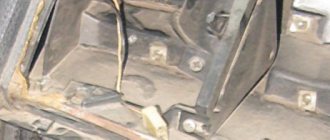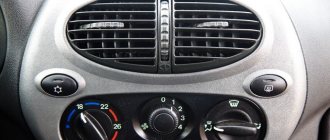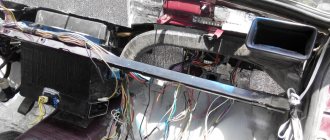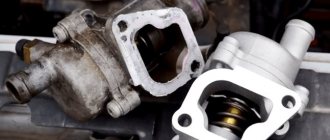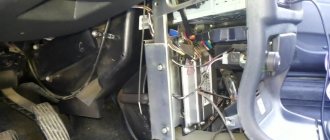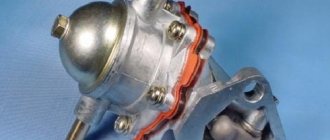Operating principle of the furnace system
As soon as the temperature outside the window drops below zero degrees, coolant in the car begins to flow directly through the furnace tap. After the engine warms up to the optimal temperature (about ninety degrees), antifreeze will begin to flow into the radiator.
Inside the car there is a special lever on the panel that is responsible for turning on the ventilation system. In the VAZ 21099 it is equipped with three power modes. You can also select the direction of the air flow. The air is directed using shock absorbers located at different points in the car.
Reasons for decreased performance
Despite the simplicity of the design, problems with the VAZ-2114 stove often arise. They are mainly associated with a drop in the performance of the heating system - the stove heats the air poorly, blows cold or slightly warm air. In this case, the reasons for poor operation of the stove can be both general (warming up is weak at any control unit settings) and when operating in a certain mode, for example, at idle. Or, for example, cold air or slightly warm air blows only on the side windows, and in other modes the heating works normally.
Common reasons why the stove stops heating:
- the heater radiator is clogged or an air lock has formed in it;
- when switched to heating mode, the heater damper does not fit tightly to the body, which is why part of the air flow moves bypassing the radiator and enters the cabin cold;
- the tap does not open completely - this is one of the main reasons for a poorly heating stove;
- the formation of cracks at the joints of the housing and air ducts, which causes strong dispersion of the air flow.
It is not difficult to determine the cause of a general decrease in the efficiency of the heating system. To find out why the VAZ-2114 stove does not heat well, you need to remove the side decorative panels from the center console, and then warm up the engine and turn on the stove at maximum power. After this, we try the antifreeze supply pipe to the heater radiator up to the tap and behind it. The same heating temperature of the tube on both sides indicates that the tap is working properly and the problem lies in the radiator. If after the tap the pipe is less warmed up, the tap is jammed or does not open completely.
After this, we determine the temperature at the inlet and outlet pipes of the radiator. If the heat exchanger is not clogged and there is no plug in it, then the temperature of the outlet pipe will be lower than the inlet pipe. But if the outlet tube is cold, antifreeze does not circulate through the radiator, which indicates the formation of an air lock (airing) or clogging.
A common cause of failure of the VAZ-2114 stove is wear and play in the sliders. Because of this, even when they are moved to their extreme positions, the cables do not bring the valve and dampers to the stop (the valve remains closed, and the dampers do not block the air flow channels). This problem can be easily resolved - you need to make an adjustment and shorten the cables a little.
The problem of insufficient heating of one of the zones is associated with a violation of the damper control. This happens due to the same wear on the sliders, the cable jumping off the damper levers, the damper axes jumping out of the seats in the body, which is accompanied by clicks.
In addition to weak warming up, VAZ-2114 car owners are faced with the fact that the intensity of air flow decreases. This happens due to the dispersion of air through the cracks at the junction of the body and air ducts, clogging the latter with debris - many owners do not install cabin filters, so leaves get into the air ducts and interfere with air movement.
Broken gear motor or heater
In almost all cases, a non-working gear motor is easier to replace. In order to release this element, it is necessary to remove the windshield wiper, “jabot” and unscrew the screws. After this, you need to remove all the wires going to the gearmotor, and then remove it too. Next, change the non-working element and adjust the air supply.
The heater malfunctions very rarely, but it should also be checked. To determine its condition, you need to dismantle the main deflector and also straighten the fasteners. Large amounts of scale or mechanical damage will indicate a non-functional condition.
The principle of operation of the VAZ 2109 stove
The operating principle of the VAZ 2109 heating stove boils down to the transfer of heat generated during operation of the internal combustion engine to air taken from outside. The car interior is heated last. Heating is carried out exclusively while the engine is running. Antifreeze acts as an intermediary that transfers heat. It is this that removes excess thermal energy from a running engine. By circulating in the radiator channels, antifreeze heats it up. The radiator is blown with air using an electric fan. The air flow heated in this way is supplied through air ducts into the interior of the VAZ 2109.
Operating principle of the VAZ 2109 stove: 1 – fan impeller; 2 – air duct for heating the windshield; 3 – windshield heating flap; 4 – foot heating damper; 5 – central nozzle flap; 6 – central nozzle; 7 – heater radiator; 8 – heater control damper; 9 – driver’s foot heating window; 10 – internal ventilation duct.
The operation of the stove not only ensures a comfortable temperature in the car interior for the driver and passengers, but also prevents the formation of condensation on the windshield (warm air blows it through special nozzles).
Basic malfunctions and methods for their elimination
There can be many reasons for the malfunction, here are the most common ones.
Warm air does not flow well into the cabin or does not flow at all
Malfunction of the fan or switch handle - one of the common reasons is a breakdown of the electric motor of the fan, wiring, or switch handle.
Test methods - to check this fault it is necessary; turn on the vehicle ignition, turn the control lever to the first position, listen.
The sound of the fan should be audible in the cabin, if not, then you need to open the hood and listen there. If the sound of the fan is not heard, the reason is in it or the switch.
Troubleshooting - remove the fan motor, check it, if it is fixed, check the serviceability of the wiring and the switch handle and fix the problem.
Malfunction of the air ducts - if the fan is working, but the air does not enter the cabin.
Test methods - to check, you just need to turn on the heater fan, open the air ducts and check with your hand one by one whether air is supplied to the windshield, side windows to the feet and the top of the driver and passenger.
Elimination - you need to check the air ducts; most likely they are clogged with dust, leaves or fluff. If again air does not enter the cabin, you need to check the functionality of the air duct dampers.
Cold air is blowing from the stove VAZ 2109, 21099
On a frosty winter day, going on a long trip, planning that this trip will be comfortable thanks to the stove, turn it on and... be horrified, because cold air is coming from the stove! What to do in such a situation?
The simplest way to solve the problem is to tighten the radiator damper cable. It can be found on the radiator housing, located near the gas pedal.
Front-wheel drive VAZ models often experience a breakdown such as incomplete opening of the heating tap. Diagnostics is carried out by comparing the temperature of the radiator pipes. In the case when the temperatures differ, we can say with confidence that the tap is not closed completely, which is why cold air is blown out instead of warm. The solution to the problem lies, again, in tightening the valve control cable and adjusting it.
It also happens that the air pumped by the stove escapes through the cracks in the air vents. Leaks lead to this problem. A simple sealing of the seams will help return everything to normal and again enjoy the warmth of your favorite stove.
Antifreeze leak VAZ 2109
Antifreeze leakage in the ninth VAZ model is one of the most common problems. This suggests that, first of all, you need to work on the cooling system; it’s time to change the pipes.
But why does the release occur?
Firstly, this may well be trivial wear and tear of components. As a rule, hoses and pipes fail to work properly, since they are made of fragile material in VAZ cars.
Low quality parts, as well as defects and wear, directly affect the health of the radiator. Components from a careless assembler lead to multiple problems that have the most detrimental effect on both the heating system and the entire operation of the car.
One of the most vulnerable elements of the stove is the expansion tank. Plastic, this word alone makes one suspicious, is not able to withstand such powerful loads that fall on this part, which is certainly important for the car. And, if many foreign cars are equipped with a reliable, durable tank, the domestic manufacturer has not yet thought of this trick and year after year produces cars with a plastic tank that regularly becomes incapacitated. It is useless to repair it; it is easier to replace it with a new one.
Now it’s worth figuring out how to determine the release of coolant.
If oil stains remain under the car when parked for a long time, there is no doubt that antifreeze is leaking.
This problem can also be determined by the smell: during normal operation of the car, the interior should never smell of it.
Sometimes you can see white smoke coming out of the exhaust pipe. Poor quality gasoline? It’s possible, but more likely it’s an antifreeze leak.
You can prevent breakdowns by regularly checking the condition of the car and its components for wear, especially the timing belt.
Now that all the basic m are known
points regarding the malfunction of the VAZ 21009 radiator, you can safely try your hand as a car mechanic. A little skill, patience and a detailed description of the diagnostic procedure will help you avoid mistakes and unnecessary expenses at the service station.
Good luck on your journey!
Design of the washer on the “nine”
The diagnostic procedure is perceived as more accessible if you are familiar with the design of the module. And here it is, almost like on the Lada Vesta - it consists of simple elements:
- tank;
- 2 motors (rear and front);
- pipelines;
- 3 injectors (two on the front of the hood, one on the rear);
- wiring.
This concept has become widespread on new hatchbacks. Carburetor versions have a different layout. One motor and two electromagnetic valves (EMVs) are installed there, distributing, respectively, to two channels.
The VAZ 2109 stove does not heat well, what should I do?
The VAZ 2109 stove does not heat well. How to correct the situation?
Hello dear readers of the blog RtiIvaz.ru. I bring to your attention another article from the “Auto Advice Experience” section about how poorly the VAZ 2109 stove heats. The topic of the VAZ 2109 stove not working and heating poorly is especially relevant before the winter period of operation. The advice of experienced drivers is that “the sleigh needs to be prepared in the summer.” This is true for several reasons. In winter, at sub-zero temperatures, it is much more difficult to carry out any work related to draining the coolant; rubber pipes become unyielding in the cold. If you need to replace radiator pipes, you can go to the Auto-RTI blog, where they are presented in the widest range and supported by photographs.
When performing this work in the summer, based on auto experience, you can simultaneously replace the coolant with troubleshooting if it has expired. In addition, antifreeze itself is always cheaper in the summer than when the first cold weather sets in. One last unnecessary advantage when the stove doesn't work. This mainly applies to VAZ owners, where the heater valve, for reasons unknown for many decades, is installed in the car interior before it leaks, and coolant gets onto the interior carpet.
Even in summer this causes a lot of trouble for the owner, and in winter it is generally a difficult task to further dry the carpet. Leakage is associated precisely with the seasonal turning on of the faucet. If there is already dirty antifreeze in the system, then the dirt accumulated in the faucet sticks to the opening of the faucet, the internal seal is cut, and the antifreeze begins to leak.
From here the conclusion is that it is possible to perform revision operations with further repairs; it is necessary and convenient to perform them in the warm season. Everyone knows how to check the stove; with the engine fully warmed up, you need to turn on the heater fan and move the damper to the “open” position. A stream of hot air will indicate that it is in good working order and ready for use in winter. If, when the engine is fully warmed up, lukewarm air flows out, does not heat well, or is generally cold, then it is necessary to find the cause and eliminate the malfunction.
The car's heater does not heat well, reasons for failure:
- Radiator clogged
- The heater valve is stuck in the “closed” position. Another option is possible here. The valve control drive is faulty. This usually happens when the fixation of the pawson disappears and it begins to walk along with the vein. In such cases, it is necessary to open the tap manually
- Low level of antifreeze in the system
- The thermostat is faulty, the engine does not warm up completely
- The antifreeze supply pipes are clogged with dirt. This is especially true for front-wheel drive cars, the V8 family, where the pipes do not have a very good angle and are often clogged with dirt, almost a third of the length
- The air supply damper is closed or jammed or the drive to open it is faulty
In these cases, advice from car experience when the VAZ 2109 does not heat well:
- The heater radiator is either unsoldered, cleaned or replaced
- heater valve needs to be replaced
- Antifreeze is topped up to normal
- faulty thermostat - replaced
- supply pipes are cleaned or replaced with new ones
Basically, the stove does not heat well due to the above-mentioned failures; by eliminating them, YOU will achieve cabin warmth.
You may also be interested to know:
Valve seal replacement operation
Look at photos of auto hoses
Cooling system pipes
Repair and scheduled maintenance of the stove for VAZ 2109
Speaking about repairing the stove on a VAZ 2109, it should be noted first of all that most of the problems with this unit can be avoided by carrying out scheduled maintenance. It is its absence that causes sudden breakdowns at the most inconvenient moment (cold season).
The most important points are as follows:
- Regularly inspect air ducts and dampers - remove accumulated debris, clean the cabin filter, check the functionality of the dampers.
- If the seals on the dampers are worn out, they need to be replaced as soon as possible.
- When the dampers do not close tightly, you need to tighten the control traction cables.
- Antifreeze needs to be replaced regularly. The specific period depends on the brand and here you need to follow the manufacturers’ instructions.
- The tubes and the radiator itself need to be cleaned only with special branded liquids. Any amateur activity, for example using a sewer cleaner, will lead to failure of both the rubber tubes and the metal radiator (it will simply dissolve).
- The easiest way to remove a leaking faucet or not allowing antifreeze to pass through at all is to remove it from the system or replace it with a more wear-resistant tap. But in this case, it will become impossible to control it from the cabin through the rod and lever.
- The antifreeze level in the expansion tank must always be maintained at the proper level and when it drops, add what is missing.
Diagnosis of the reasons why the stove heats poorly on a VAZ 2109 should be carried out at medium engine speeds. The air temperature from the stove nozzles should reach 80-90 degrees Celsius in 5-10 minutes. Warming up the interior to +5 degrees from -10 degrees occurs in 10 minutes of operation of the stove.
Let's sum it up
The washer sprayer on a VAZ 2109 may not work for many reasons:
- there is no liquid in the tank;
- the motor is broken;
- solenoid valve stuck;
- fuse F7 burned out;
- the steering column switch is broken;
- the wire is broken;
- the injectors are clogged.
All faults are diagnosed by elimination. In some cases, a multimeter is used.
The system is upgraded by installing a high-performance pump, check valve and filter. A common tuning procedure is the installation of two motors and removal of the EMC valves.
Source: autobann.su
Tuning VAZ 2109
The cold weather has arrived, and most owners of the VAZ 2109 are once again faced with a problem: from the nozzles of the heater pipes at the operating temperature of the coolant (about 90 degrees), barely warm, and often completely cold air is blowing into the cabin; in short, the heater does not heat well. In this state of affairs, in severe frost, even frosty side windows in the cabin “do not come off.”
The simplest solution to this problem is as follows. It is necessary to tighten the heater damper control cable. To do this, you can make one or two turns of this cable on the damper control lever. This lever is located on the body of the VAZ 2109 stove, next to the gas pedal (see photo).
Location of the VAZ 2109 heater damper lever
All the joints of the air ducts and the edges of the stove damper are covered with foam rubber, which is difficult to fully compress using the damper control lever. This leaves a gap of several millimeters. In this case, the damper directing the flow of air either from the street directly or through the heater radiator does not close completely. It closes “up”, while air flows into the front nozzles through the heater radiator, and into the top and side nozzles from the street, through those same millimeters. When the heater fan is running, and the car is moving, these millimeters are quite enough.
You can even get to this damper lever on the driver's side and try to tighten this lever with your hand while the heater fan is on. In this case, the left ear will be in the area of the air duct nozzle, and you can hear how the sound and temperature of the air leaving the nozzle changes.
Also, the reasons discussed below may be the reason for the ineffective operation of the Samara interior heating system.
Incomplete opening of the heater tap
This problem occurs in most front-wheel drive VAZ cars. You can check this by comparing the temperature of the inlet and outlet pipes of the heater radiator; if it is different, most likely the valve is not fully open. The solution is to tighten the control cable for this valve and adjust the valve control lever to the maximum open position. In this case, it is possible that now the valve will not close completely, but as they say, the heat does not break the bones. But here lies another problem. It is known that this valve in Samar is a weak point, and after a certain number of “open-close” operations, the valve at the location of the axis connecting the control lever and the valve itself inside the valve loses its tightness and begins to leak. Some owners simply set the “heat-cold” lever to a certain position and leave it out of harm’s way. In this case, attempting to move the heater tap valve will most likely cause it to leak. If this happens, you can wrap a strip of fabric soaked in sealant around the leak site and fix it all with “cold welding”; this can also be done in the field if the necessary materials are available.
Location of the Lada Samara stove valve leak
A radical solution to the problem with a leaking heater tap on the VAZ 2109 would be to completely remove it from the system, or install a water supply ball valve. True, in the first case, the ability to adjust the volume of coolant entering the heater radiator is lost, and in the second case, this adjustment can only be made by looking under the hood. But, having got rid of a obviously unreliable unit, we get rid of possible problems in the future, and the remaining adjustment of the temperature of the air entering the cabin by the damper is enough for the eyes. By the way, in the “tens” the manufacturer removed this ill-fated valve.
Air duct leaks
The air forced by the stove fan partially goes into the cracks in the air paths, while the air flow weakens and cools. The solution would be to seal and seal all connections along the air path from the stove to the outlet nozzles. True, this operation is very labor-intensive, since you will have to disassemble the entire front panel, but the result will be a noticeable increase in air flow from the heating system deflectors.
Air locks in the heater core
This problem is indicated by cold air from the cooling system deflectors when the heater valve is open at the operating temperature of the coolant. In this case, you need to place the car with the front wheels on a hill, as high as possible, open the heater valve fully and turn on the gas.
Also, to warm up the interior, I recommend installing a 6-hole thermostat from a VAZ 2110 according to a modernized design.
The tap is not fully open
To check this, whether for this reason, it is enough to compare the temperature of the inlet and outlet pipes of the heater radiator; if it is different, then there is a high probability that the valve is not completely closed.
This problem can be solved by tightening the valve control cable and bringing the control lever to the maximum open position. But there is a danger that after these actions the valve will not close completely and it will be very hot in the cabin.
In addition, the valve has a big drawback - it is “designed” for a certain number of openings and closings. Where the axis of the control lever and the damper inside the valve connect, the tightness is lost and a leak forms over time. A solution may be to set the lever to the “hot-cold” position without further adjustment.
Usually, when you try to move the valve of the heater stove, a leak occurs, in this case, wrap the leak area with a strip of fabric soaked in sealant and fix it all with “cold welding”.
Why does the stove blow cold air?
If the heater radiator on a VAZ-21099 has stopped heating, most likely the coolant circulation in it has been disrupted. This problem is also caused by a number of reasons, let’s look at them:
- It is quite possible that the coolant is outdated and, as a result, has lost its properties. Note that its service life is approximately five years. If during this time the antifreeze or antifreeze has never been changed, their structure begins to deteriorate with the formation of sediment, which, settling on the cooling lines, interferes with the normal operation of the system. This sediment also clogs the radiator, pipes and pipes of the heater, causing it to stop functioning normally and giving off heat. Therefore, it is necessary to free the system from the old cooling fluid by completely draining it, and then flush it using a special flushing compound. This liquid is poured into the cooling system, after which the power unit starts. The manufacturer indicates on the packaging how long it takes to use the flushing compound in the system with the engine running before draining it. After the flushing has been drained (it usually comes out of the system quite dirty), new coolant should be added in accordance with the manufacturer's instructions and the heater's performance checked. If after this the stove still does not heat, then its radiator is clogged. If, after cleaning and washing it, performance is still not restored, you will have to buy a new radiator.
- One of the most vulnerable elements of the cooling system is the heater valve, which is controlled from inside the car using a special lever on the heater panel. The lever and faucet have a traction connection. It is necessary to check the functionality of the faucet. This is done like this: we move the lever, while controlling the opening and closing of the tap. If the faucet remains motionless or does not open/close completely, then the draft needs to be adjusted.
- The VAZ-21099 stove heats poorly or does not work at all due to a drop in the antifreeze level in the cooling system. Because of this, air accumulates inside the heater radiator, and it practically does not function (it gives off little heat). To eliminate this, you only need to replenish the level of “cooling” in the system and constantly monitor it.
- Airiness in the cooling system of the power unit is also a common cause. The carburetor has a heating pipe, which must be disconnected, since it is the highest point of the system, and accordingly, an air lock forms there. The next step is to free the system from air; to do this, remove the cap of the expansion tank and blow it out. Air will begin to escape from the hose that was previously removed from the carburetor, but as soon as coolant flows in instead, the hose must be put back in place. Air in the system has been eliminated.
- The cause of the malfunction of the VAZ-21099 heater may be a failed thermostat, because of which the power unit does not reach the required temperature (90 degrees).
- Failure of the pump deprives the cooling system of fluid circulation. At the same time, the engine boils and cold air blows from the air ducts. In this case, it is recommended to replace the pump.
As you can see, there are several reasons for poor operation of the stove in the VAZ-21099, and each of them is a consequence of other malfunctions.
Diagnosing Heater Problems in a 2012 Jeep Wrangler (and Others)
The Jeep Wrangler has a heater actuator problem that is almost the same as the Jeep Liberty. This problem is described below and then we will talk about another known problem with sandy material clogging the system.
Drive fix
Unfortunately, the Jeep Wrangler doesn't have as much behind-the-dash access as the Jeep Liberty. But you can tell if you need to start disassembling your panel by simply looking behind it on the left side.
As with the Jeep Liberty, the air conditioning and heating system is the center dial on the dash. This opens and closes the damper behind the dash to determine how much hot or cold air is entering the system. This is controlled by an electronic part called an actuator. It simply goes up and down to open and close the damper.
What you need to do is look under the dash and find the white plastic piece that moves when you turn the dial. You may need a light to shine there and see it all clearly and clearly.
If you see the white plastic moving, then the problem is not the drive and your problem may be sand deposits, as described in the next section. But if you see the white plastic part and it doesn't move, then your drive has failed.
As I said, the layout of this drive is a little more complex than on the Jeep Liberty. There is a panel on the left side under the steering wheel that can be removed for more access. This may not be ideal access to it, but it will mean you can remove the drive without removing the entire panel.
Once the actuator is removed, you can open the damper manually by turning the gear to which the actuator is attached. Start the engine and after a few minutes, see if heat escapes into the cabin.
Poor windshield airflow
One of the problems with the ventilation and heating systems of VAZ models is poor airflow through the windshield. Many owners, complaining about design flaws, try to make modifications or turn to service center specialists for help. However, in most cases, if the windshield blows poorly, the problem is not some kind of defect, but a simple adjustment.
As practice shows, weak windshield airflow is primarily caused by the damper. More precisely, all the problems are due to the fact that the damper control cable has become loose or has fallen off the lever. It just needs to be pulled up or put in place.
Repair and scheduled maintenance of the stove for VAZ 2109
Speaking about repairing the stove on a VAZ 2109, it should be noted first of all that most of the problems with this unit can be avoided by carrying out scheduled maintenance. It is its absence that causes sudden breakdowns at the most inconvenient moment (cold season).
The most important points are as follows:
- Regularly inspect air ducts and dampers - remove accumulated debris, clean the cabin filter, check the functionality of the dampers.
- If the seals on the dampers are worn out, they need to be replaced as soon as possible.
- When the dampers do not close tightly, you need to tighten the control traction cables.
- Antifreeze needs to be replaced regularly. The specific period depends on the brand and here you need to follow the manufacturers’ instructions.
- The tubes and the radiator itself need to be cleaned only with special branded liquids. Any amateur activity, for example using a sewer cleaner, will lead to failure of both the rubber tubes and the metal radiator (it will simply dissolve).
- The easiest way to remove a leaking faucet or not allowing antifreeze to pass through at all is to remove it from the system or replace it with a more wear-resistant tap. But in this case, it will become impossible to control it from the cabin through the rod and lever.
- The antifreeze level in the expansion tank must always be maintained at the proper level and when it drops, add what is missing.
Diagnosis of the reasons why the stove heats poorly on a VAZ 2109 should be carried out at medium engine speeds. The air temperature from the stove nozzles should reach 80-90 degrees Celsius in 5-10 minutes. Warming up the interior to +5 degrees from -10 degrees occurs in 10 minutes of operation of the stove.
How to avoid the problem
If the airflow in your car works well, and you want it to continue to work that way, then you should follow a few simple rules:
- Use high-quality and suitable coolant.
- Monitor the coolant level and add it immediately if necessary.
- Periodically clean and vent the radiator to avoid severe clogging.
- Monitor the condition of the stove fan and if it loses power, replace it (preferably with a fan from a foreign car, as discussed above).
Following this will help avoid most of the troubles that may arise with the interior airflow system.
Features of the VAZ 2109 heating system
Ventilation in the cabin is supply and exhaust. Special holes located in the windshield trims serve to allow air to flow through them, which is supplied spontaneously or forcefully by the heater fan. Air escapes through the cracks between the panels inside the doors or holes in the ends. Valves built into the holes allow air to pass out and prevent it from getting inside. This improves thermal insulation in the cabin. The engine cooling system includes a stove, a heater radiator, which is located parallel to the main radiator, a faucet, a pump, and an electric fan.
Heating system of a VAZ 2109 car
- The stove is fixed in the cabin under the dashboard to the bolts with four nuts. The bolts are welded to the air supply box. The seal between the air ducts and the stove is made with gaskets. The stove consists of two plastic casings, left and right, connected around the perimeter with brackets. A special harness is placed in the grooves of the casings for sealing.
- A radiator is installed in the heater casings, it is fixed to the right casing and sealed with a polyurethane gasket. The device includes:
- two rows of tubes;
- cooling plates;
- two plastic tanks.
The air is heated in the radiator and is directed into the passenger compartment through a system of air ducts fixed from below to the dashboard:
- An electric fan is attached to the top of the heater with two screws; it can be easily removed from the engine compartment. The impeller of the electric fan, mounted on the shaft of the electric motor attached to the fan casings, has three rotation speeds due to two resistor spirals. An additional stove resistor allows the impeller to obtain the desired rotation speed, and it is mounted on the left side in the hole in the stove casing.
- The stove faucet consists of a body and two pairs of pipes. It is connected by rubber hoses to the cooling system. A plate valve is mounted in the valve body, allowing coolant to pass through. Its lever is connected to the handle lever by a rod, due to this it is possible to control the air heating. The hole in the valve opens when the lever is turned, and fluid will begin to flow into the radiator.
- The pump circulates liquid through the radiator. Three handles control the stove. Their levers are mounted on the axles of a bracket made of plastic and attached with four screws to the instrument panel. The lever that actuates the damper, and through the rod on the valve lever, is affected by the heating control handle.
- The damper and tap open completely when you move it all the way to the right. In this case, air is supplied through the radiator by an electric fan and the heated liquid is circulated for cooling.
- When the handle is positioned in the middle, the valve and tap have an intermediate position. In this case, part of the air passes through the radiator, the other bypasses it, which ensures the desired degree of heating of the air in the cabin at the moment.
- The position of the handle in the extreme left position completely closes the heater valve and the control damper, and the air entering the cabin is not heated. Air is supplied to the feet of passengers and the driver by the upper left handle, connected by a rod to the damper lever.
- Moving the handle to the left opens the foot heating flap, and the air from the casings is directed into the windows. Air is supplied to the feet of the driver and passenger in the front seat from both sides; it is supplied to the rear seats through the internal ventilation air duct.
- The air supply to the windshield is carried out by a handle connected by a rod to a lever that drives the heated glass flap drive, which opens or closes the entry of air through the air duct onto the glass.
Air for passengers and blowing the side windows comes through the side - left and right, and two central nozzles of the car's heater. Their bodies are equipped with a damper with a polyurethane foam seal. The intensity of the air flow changes by closing or opening the damper with a lever, and by turning the lever of the nozzle with guides and blades, you can change the direction of air movement. The stove provides the following temperatures at an ambient temperature of -20°C, at maximum heating mode:
- +25°С – in the leg area.
- +20°С – in the interior of a VAZ 2109 car.
Finalization
The main reason for the “wrong” behavior of the stove is the poor placement of the diaphragms, which either do not come off completely or do not close completely. Moreover, the problem is solved in practice by simply altering the lever. To do this you will need a plastic card. You can use an unnecessary discount card or an expired bank card.
This is done as follows
- Remove the decorative plastic that covers the heater from below;
- Remove the damper position regulator. The lower part is removed from it; it is responsible for the operation of the front damper. This should be done carefully, the plastic here is fragile, one awkward movement and you will have to restore the part using a soldering iron;
- We fix the lower flap in the upper position. To do this, we cut out a suitable bracket from simple sheet metal and secure it with self-tapping screws. After this, you will completely lose the frontal position;
- Next, we take a plastic card and cut out a new path in it for the movement of the damper drive. Glue the resulting blank onto the damper. For greater accuracy, we file all the side parts;
- After that, all that remains is to put everything back in place.
Read more: Elm327 mini how to connect As a result, we get the ability to distribute air to the windshield or to the feet of your choice. You can also relatively smoothly regulate the amount of air supplied in different directions.
After such a modification, you may encounter a decrease in air flow. This is due to air redistribution. The result is that in the middle position the cabin is still quite cool. To eliminate this drawback, you will need an unnecessary plastic canister. We cut off the neck from it and attach it to the deflector. The result is a fairly powerful and targeted flow.
